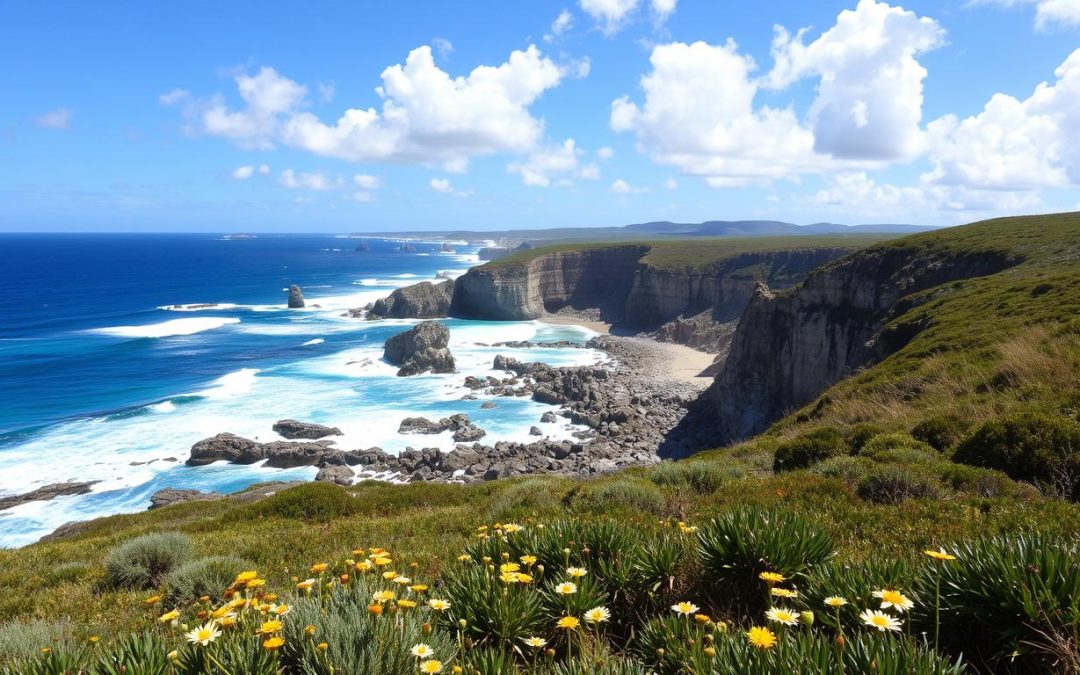Have you ever wondered where nature’s most breathtaking coastal landscapes truly come alive? Torndirrup National Park in Western Australia offers an extraordinary adventure. It will transform your understanding of wilderness and spectacular scenery.
Located just near Albany, this remarkable national park spans a unique coastal terrain. It stretches approximately 50 minutes from west to east. Situated 420 km from Perth, Torndirrup National Park represents one of Western Australia’s most stunning natural destinations for outdoor enthusiasts and adventure seekers.
Your journey through Torndirrup National Park promises an immersive experience in raw, untouched wilderness. From dramatic cliff formations to pristine beaches like Misery Beach (named Tourism Australia’s Best Beach for 2022), you’ll discover why this destination is among the top picks for nature lovers.
Key Takeaways
- Spectacular coastal landscapes just 420 km from Perth
- Home to Misery Beach, Tourism Australia’s Best Beach in 2022
- Offers diverse natural attractions and hiking opportunities
- Perfect destination for wildlife and landscape photography
- Unique marine and terrestrial ecosystems to explore
Getting to Torndirrup National Park
Planning your trip to Torndirrup National Park needs thought about how to get there and when. It’s 420 km from Perth. You can explore its amazing views in several ways.
Self-Drive Options from Perth
Driving is the best way to get to Torndirrup National Park. It lets you choose your route:
- Inland route: A direct 400 km drive
- Coastal route: Scenic 600 km journey
- Recommended vehicle: Rental car with good ground clearance
Public Transportation
Public transport is not as common, but you can get to Albany by bus. Here’s what you need to know:
- Bus connections available from Perth to Albany
- Local taxi or tour services can transport you to Torndirrup National Park
- Book transportation in advance during peak seasons
Best Time to Visit
Each season at Torndirrup National Park has its own charm:
| Season | Highlights |
|---|---|
| Spring (Sept-Nov) | Mild weather, wildflower blooms |
| Winter (Jun-Aug) | Whale watching opportunities |
| Summer (Dec-Feb) | Beach activities, clear skies |
“The journey is as remarkable as the destination” – Local Albany traveler
Make sure to prepare well, check the park’s conditions, and enjoy Torndirrup National Park’s beauty!
The Gap and Natural Bridge: Nature’s Spectacular Show
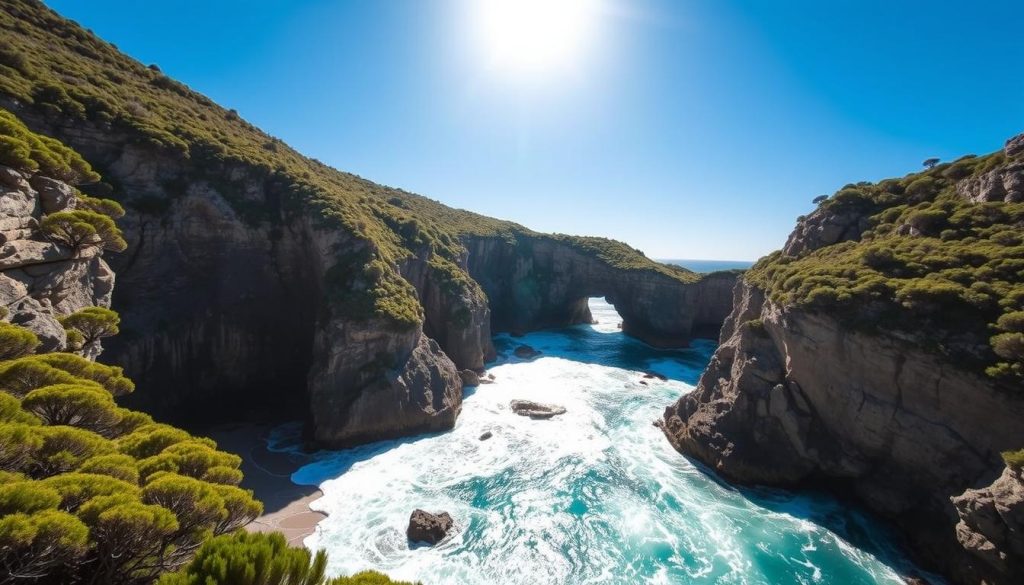
Torndirrup National Park is home to two amazing coastal sights: The Gap and Natural Bridge. These formations show the Southern Ocean’s power, leaving visitors in awe.
The Gap is a 40-meter deep chasm carved into granite. Here, waves crash against the ancient walls. From a special viewing platform, you see the ocean’s force up close. The vertical drop and waves make for a stunning sight.
- Depth of The Gap: 40 meters
- Rock type: Granite cliffs
- Best viewing times: Sunrise and sunset
Nearby, the Natural Bridge is a rock arch shaped by the sea. It’s a marvel of coastal erosion, inspiring wonder in all who see it.
“Nature’s greatest artwork is carved by patience and persistence” – Unknown
Photographers love these spots. The light, rock, and water make for amazing photos, especially at sunrise and sunset. The light then turns the scene into a beautiful picture.
| Feature | Description |
|---|---|
| The Gap | 40-meter deep granite chasm with dramatic wave action |
| Natural Bridge | Rock arch formed by centuries of ocean erosion |
| Best Photography Time | Sunrise and sunset |
When you visit, wear good shoes and bring a camera. Always follow safety rules. The platforms are safe spots to enjoy the views without danger.
Exploring the Famous Blowholes
Torndirrup National Park is home to amazing blowholes. These natural wonders show off the power of the ocean. They draw visitors from all over the world.
The blowholes act like giant water fountains. Ocean waves push air and water through narrow rocks. When it’s just right, they can shoot water high into the air, making a big splash.
Safety Precautions for Blowhole Viewing
Seeing the blowholes is exciting but you must stay safe. Here are some important rules:
- Always stay behind designated safety barriers
- Wear sturdy, non-slip footwear
- Maintain a safe distance from water’s edge
- Watch ocean conditions carefully
- Never turn your back on the ocean
Best Viewing Times
For the best blowhole views, pick the right times. The most stunning sights happen during:
- High tide periods
- Strong ocean swells
- Early morning hours
- Late afternoon
Photography Tips
Here’s how to capture the blowholes’ beauty:
- Use a wide-angle lens to capture landscape scale
- Experiment with different shutter speeds
- Freeze water spray with fast shutter settings
- Create misty effects with slower exposures
“Nature’s most spectacular shows often arrive unexpectedly – patience is your greatest photographic tool.”
The blowholes in Torndirrup National Park are a must-see. They show the power of nature and the ocean. By being careful and choosing the best times, you’ll see one of Western Australia’s top coastal sights.
Stony Hill Heritage Trail and Lookout
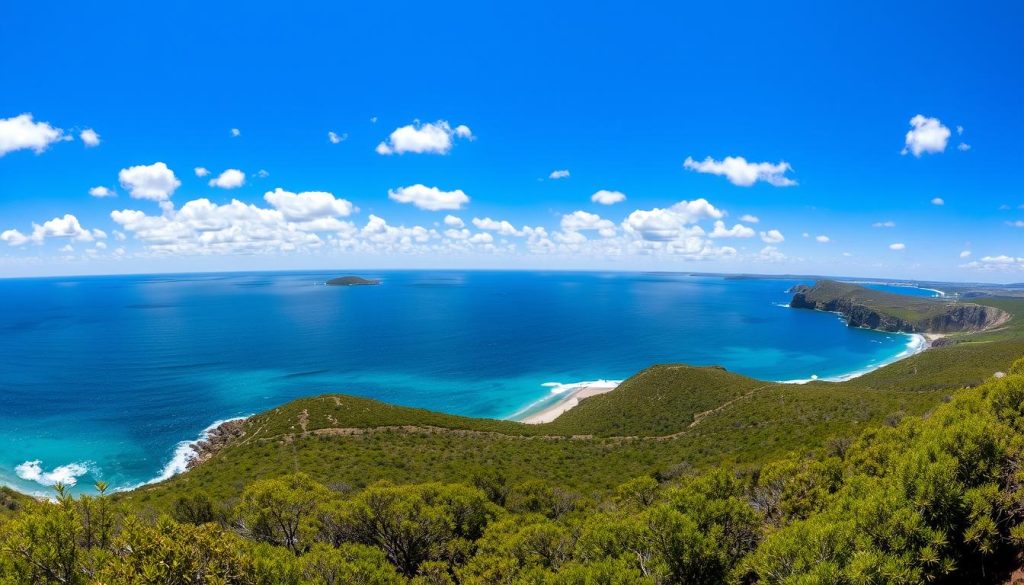
Explore the Stony Hill Heritage Trail, a 500-meter path in Torndirrup National Park. It’s a hidden treasure that mixes stunning views with history. Walking this trail, you’ll see sights that will amaze you.
The Stony Hill lookout is a top spot to see the Southern Ocean coastline. Hikers will love the trail’s mix of granite and coastal heathland. It’s well-kept and offers great views.
Key Highlights of the Stony Hill Heritage Trail:
- Trail Length: 500 meters
- Estimated Completion Time: Less than 1 hour
- Accessibility Grade: Grade 3
- Spectacular 360-degree views of King George Sound
Nature fans will love it during wildflower season (August to December). The trail is full of colors then. Don’t forget your binoculars for wildlife and whales in migration season.
“The Stony Hill Heritage Trail offers a perfect blend of natural wonder and historical exploration.” – Local Nature Guide
Photography lovers, history buffs, and outdoor seekers will find something special here. The Stony Hill Heritage Trail is a must-see in Western Australia’s beautiful landscapes.
Whale Watching Opportunities
Western Australia is a top spot for whale watching. The season runs from May to October. Torndirrup National Park is a great place to see whales in their natural home.
Peak Season Guide
The best time for whale watching is from June to September. The coastal waters are filled with whales during these months. You’ll see them migrating along the beautiful Western Australian coast.
- Best months: June to September
- Peak viewing times: Early morning and late afternoon
- Recommended watching duration: 2-3 hours
Best Viewing Locations
Torndirrup National Park has great spots for whale watching. These places offer amazing views of these huge creatures.
| Location | Viewing Characteristics | Recommended Time |
|---|---|---|
| The Gap | 40-meter high granite cliff with panoramic ocean views | Early morning |
| Natural Bridge | Elevated coastal platform with wide viewing angle | Late afternoon |
| Jimmy Newell’s Harbour | Sheltered area with close marine proximity | Mid-morning |
Species You Can Spot
While watching whales, you might see many marine mammals. Humpback and southern right whales are common. But, you might also see blue whales and orcas.
“Patience and a good pair of binoculars are your best companions during whale watching in Torndirrup National Park.” – Local Wildlife Guide
For a deeper experience, try a guided whale watching tour from Albany. These tours go to the best whale spots. You’ll have a chance to see whales up close.
Shelley Beach and Coastal Attractions
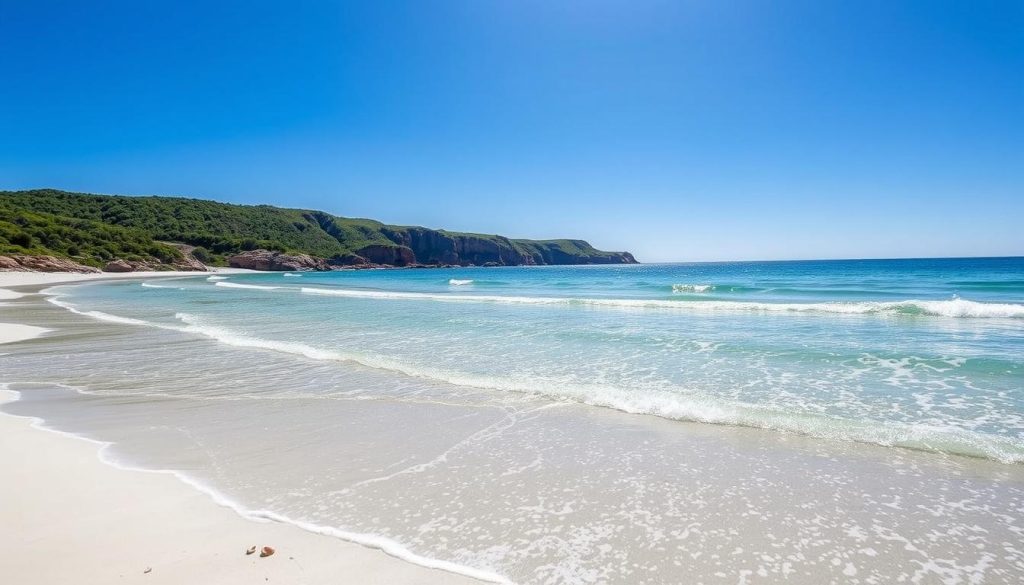
Shelley Beach is a hidden gem in Torndirrup National Park, Western Australia. It offers a stunning escape into the coastal paradise. Visitors get to see the raw beauty of the Southern Ocean through its scenic views.
Exploring Shelley Beach reveals why it’s a top spot. The white sand beach is framed by dramatic granite cliffs. It’s perfect for beach lovers and photographers.
- Swimming in calm, crystal-clear waters
- Snorkeling along rocky coastlines
- Fishing from scenic rock formations
- Capturing stunning landscape photographs
Wildlife lovers will enjoy the diverse ecosystem around Shelley Beach. Look out for kangaroos, honeyeaters, and seabirds.
- Kangaroos roaming coastal landscapes
- Honeyeaters flitting between native plants
- Seabirds soaring above dramatic cliff faces
“Nature’s beauty is most profound where land meets sea” – Local Albany Saying
There’s more to do than just Shelley Beach. The Bald Head Walk Trail offers a challenging hike with amazing views. Don’t forget to pack a picnic and enjoy the natural beauty.
Hiking Adventures in Torndirrup
Torndirrup National Park has some of the best hiking trails in Western Australia. They offer stunning coastal views and tough terrain. These trails are perfect for both seasoned hikers and casual explorers.
Bald Head Walk Trail: The Ultimate Coastal Challenge
The Bald Head Walk Trail is the park’s top hiking spot. It’s a tough 12.6 km return trail for experienced hikers. With a 80 meter elevation gain and a difficulty grade of 4, it requires good fitness and planning.
- Trail Length: 12.6 km return
- Estimated Hiking Time: 2-4 hours
- Elevation Gain: 80 meters
- Difficulty Grade: 4
Peak Head Trail: Scenic Coastal Panoramas
The Peak Head Trail is great for those who want shorter trails with amazing views. It offers wide views of the Southern Ocean and the surrounding areas. It’s ideal for photography and nature lovers.
“The views from Peak Head Trail are simply breathtaking – a photographer’s paradise and a hiker’s dream.” – Local Trail Guide
Jimmy Newells Harbor Track: A Gentler Option
The Jimmy Newells Harbor Track is a softer option for hikers. It has beautiful harbor views and is easy for all skill levels.
Pro tips for hiking in Torndirrup National Park:
- Wear sturdy hiking boots
- Carry plenty of water
- Pack sun protection
- Check weather conditions before departing
- Inform someone about your hiking plans
Embrace the raw beauty of Western Australia’s wilderness and create unforgettable memories on these incredible hiking trails.
Salmon Holes: Fishing and Beach Activities
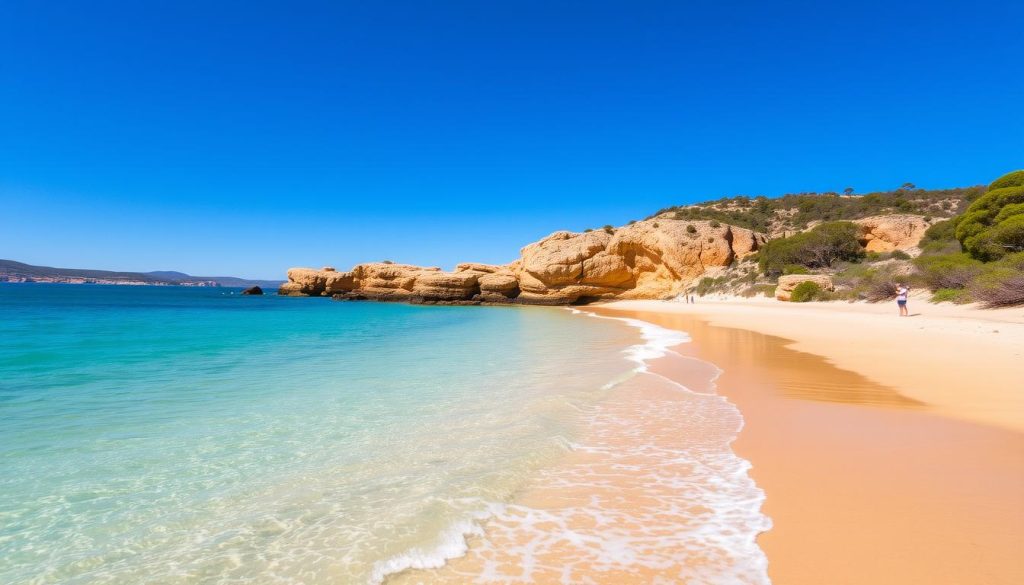
Salmon Holes is a hidden gem in Torndirrup National Park. It’s perfect for fishing and beach activities. Anglers from all over Western Australia come here for the fishing.
The beach is famous for its salmon migration from March to April. It’s a top spot for surf fishing.
- Best fishing periods: March to April
- Target fish species: Australian salmon, herring, skippy
- Recommended fishing techniques: Surf casting, rock fishing
When fishing at Salmon Holes, safety is crucial. The rocky coast can be dangerous. Always wear a life jacket and check the sea before you go.
“Salmon Holes offers more than just fishing – it’s a breathtaking coastal experience that connects you with nature.” – Local Fishing Guide
Salmon Holes is great for more than fishing. You can sunbathe, have a picnic, or just enjoy the view. Birdwatchers will love seeing sea eagles and ospreys.
| Fish Species | Best Catching Period | Recommended Technique |
|---|---|---|
| Australian Salmon | March-April | Surf casting |
| Herring | Year-round | Light tackle |
| Skippy | Summer months | Rock fishing |
Don’t forget to bring sunscreen, water, snacks, and your fishing gear. Since there are no facilities nearby, being prepared is important for a great time at Salmon Holes.
Wildlife and Nature Photography Spots
Torndirrup National Park is a paradise for photographers and wildlife lovers. It offers a stunning backdrop of natural wonders. Here, your camera will find endless inspiration in diverse ecosystems.
The park’s varied terrain offers many nature photography spots. These spots are perfect for both beginners and pros. Wildlife fans can catch amazing moments in the early morning or late afternoon.
- Spot western grey kangaroos in coastal heathlands
- Capture images of quendas (southern brown bandicoots)
- Photograph rare bird species like honeyeaters and sea eagles
For the best wildlife photos, follow these tips:
- Use a telephoto lens for wildlife close-ups
- Bring a wide-angle lens for expansive landscape scenes
- Visit between August and December for wildflower backgrounds
“Nature always wears the colors of the spirit” – Ralph Waldo Emerson
| Location | Wildlife Potential | Photography Difficulty |
|---|---|---|
| Stony Hill Area | High | Moderate |
| Coastal Cliffs | Medium | Advanced |
| Natural Bridge | Low | Easy |
Remember to respect wildlife habitats and stay on designated paths while taking photos.
Essential Tips for Visiting Torndirrup National Park
Visiting Torndirrup National Park needs careful planning. This beautiful coastal area offers amazing views and unique experiences. But, with the right preparation, your trip will be safe and unforgettable.
What to Pack for Your Journey
Packing the right things makes your visit more enjoyable. Here are the must-haves:
- Sturdy hiking shoes with good ankle support
- Waterproof jacket for changing coastal weather
- High-SPF sunscreen and wide-brimmed hat
- Reusable water bottle
- Compact first aid kit
- Lightweight snacks and energy bars
- Camera with extra batteries
- Binoculars for wildlife viewing
Safety Guidelines for Park Visitors
Your safety is the top priority in Torndirrup National Park. Follow these important safety tips:
- Stay behind designated safety barriers
- Check weather conditions before hiking
- Inform someone about your hiking route
- Carry a charged mobile phone
- Maintain a safe distance from cliff edges
- Watch for sudden wave conditions
Park Facilities and Amenities
Knowing what facilities are available helps plan your visit. Torndirrup National Park has:
| Facility | Availability | Notes |
|---|---|---|
| Toilets | Available | At major attractions |
| Picnic Areas | Limited | Near key viewpoints |
| Drinking Water | Not Guaranteed | Bring your own supply |
| Parking | Available | At main trailheads |
Pro tip: Always carry enough water, snacks, and be ready for limited services in the park.
“Preparation and respect for nature are the keys to an unforgettable national park experience.” – Western Australia Parks Service
Conclusion
Torndirrup National Park is a stunning gateway to Western Australia’s coastal wonders. It offers an unforgettable experience with its natural beauty, adventure, and calm. You’ll see amazing ocean views, explore rugged trails, and watch marine life.
Your visit to Torndirrup National Park lets you dive into Western Australia’s stunning southwest. You’ll see dramatic rock formations, peaceful beaches, and diverse trails. It’s a chance to connect with nature. Planning well and respecting the environment will help you make the most of your trip.
For a full southwest adventure, think about visiting Albany and other national parks nearby. A week-long trip lets you enjoy the area’s landscapes, wildlife, and culture. Bring your adventure spirit, pack right, and get ready for an amazing journey to Western Australia’s natural gem.
Remember, Torndirrup National Park is more than a place to visit. It’s a call to explore Australia’s untamed coastline. Your time here will create lasting memories of natural beauty and personal discovery.
The above is subject to change.
Check back often to TRAVEL.COM for the latest travel tips and deals.
